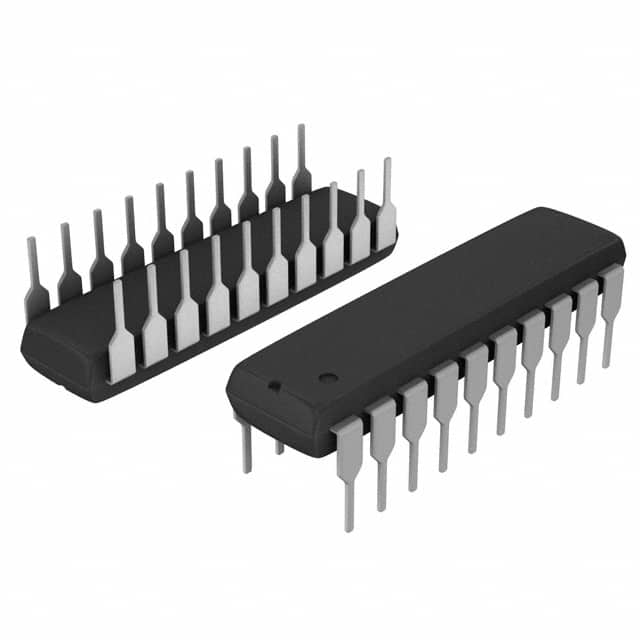Consulte las especificaciones para obtener detalles del producto.

PIC16F527-I/P
Product Overview
Category
The PIC16F527-I/P belongs to the category of microcontrollers.
Use
This microcontroller is commonly used in various electronic devices and systems for control and processing purposes.
Characteristics
- Low power consumption
- High performance
- Small form factor
- Wide operating voltage range
- Rich peripheral integration
Package
The PIC16F527-I/P is available in a DIP (Dual Inline Package) package, which allows for easy integration onto circuit boards.
Essence
The essence of the PIC16F527-I/P lies in its ability to provide efficient control and processing capabilities in a compact and low-power package.
Packaging/Quantity
The PIC16F527-I/P is typically packaged in tubes or trays, with quantities varying depending on the supplier and customer requirements.
Specifications
- Microcontroller architecture: 8-bit
- CPU speed: Up to 20 MHz
- Program memory size: 3.5 KB
- RAM size: 256 bytes
- Number of I/O pins: 18
- Analog-to-Digital Converter (ADC): 10-bit resolution, 8 channels
- Timers: Multiple timers/counters
- Communication interfaces: USART, SPI, I2C
Detailed Pin Configuration
The PIC16F527-I/P has a total of 18 pins, each serving a specific purpose. The pin configuration is as follows:
- VDD - Power supply voltage
- RA0 - General-purpose I/O pin
- RA1 - General-purpose I/O pin
- RA2 - General-purpose I/O pin
- RA3 - General-purpose I/O pin
- RA4 - General-purpose I/O pin
- RA5 - General-purpose I/O pin
- MCLR - Master Clear input
- VSS - Ground
- OSC1/CLKIN - Oscillator input
- OSC2/CLKOUT - Oscillator output
- RC0 - General-purpose I/O pin
- RC1 - General-purpose I/O pin
- RC2 - General-purpose I/O pin
- RC3 - General-purpose I/O pin
- RC4 - General-purpose I/O pin
- RC5 - General-purpose I/O pin
- VDD - Power supply voltage
Functional Features
- High-speed processing capabilities
- Flexible I/O configuration
- Analog-to-Digital Conversion (ADC)
- Timers and counters for precise timing control
- Communication interfaces for data exchange
- Low power consumption modes for energy efficiency
Advantages and Disadvantages
Advantages
- Compact size allows for easy integration into various applications
- Wide operating voltage range enables compatibility with different power sources
- Rich peripheral integration reduces the need for external components
- Low power consumption prolongs battery life in portable devices
Disadvantages
- Limited program memory size may restrict the complexity of applications
- 8-bit architecture may not be suitable for certain high-performance tasks
- Lack of advanced communication protocols may limit connectivity options
Working Principles
The PIC16F527-I/P operates based on the principles of microcontroller architecture. It executes instructions stored in its program memory, interacts with peripherals, and processes data to perform desired functions. The microcontroller's central processing unit (CPU) coordinates these operations, while the integrated peripherals provide additional functionality.
Detailed Application Field Plans
The PIC16F527-I/P finds applications in various fields, including but not limited to: - Home automation systems - Industrial control systems - Automotive electronics - Consumer electronics - Medical devices - Internet of Things (IoT) devices
Detailed and Complete Alternative Models
- PIC16F526-I/P
- PIC16F527A-I/P
- PIC16F527T-I/P
- PIC16F527T-I/ML
These alternative models offer similar functionality and characteristics, providing options for different project requirements.
In conclusion, the PIC16F527-I/P is a versatile microcontroller that offers high performance, low power consumption, and rich peripheral integration. Its compact size and wide operating voltage range make it suitable for various applications in different fields. While it has certain limitations, such as limited program memory and 8-bit architecture, alternative models are available to cater to specific project needs.
Enumere 10 preguntas y respuestas comunes relacionadas con la aplicación de PIC16F527-I/P en soluciones técnicas
What is the maximum operating frequency of PIC16F527-I/P?
- The maximum operating frequency of PIC16F527-I/P is 32 MHz.How many I/O pins does PIC16F527-I/P have?
- PIC16F527-I/P has 18 I/O pins.Can PIC16F527-I/P be used for battery-powered applications?
- Yes, PIC16F527-I/P is suitable for battery-powered applications due to its low power consumption.What communication interfaces are supported by PIC16F527-I/P?
- PIC16F527-I/P supports SPI and I2C communication interfaces.Is PIC16F527-I/P suitable for motor control applications?
- Yes, PIC16F527-I/P can be used for simple motor control applications.What is the flash memory size of PIC16F527-I/P?
- PIC16F527-I/P has 3.5 KB of flash memory.Can PIC16F527-I/P operate in harsh environments?
- PIC16F527-I/P has a wide operating voltage range and can withstand some level of environmental stress.Does PIC16F527-I/P have built-in analog-to-digital converters (ADC)?
- Yes, PIC16F527-I/P features a 10-bit ADC with multiple channels.What development tools are available for programming PIC16F527-I/P?
- Development tools such as MPLAB X IDE and PICkit programmers can be used to program PIC16F527-I/P.Is PIC16F527-I/P RoHS compliant?
- Yes, PIC16F527-I/P is RoHS compliant, making it suitable for environmentally conscious designs.

